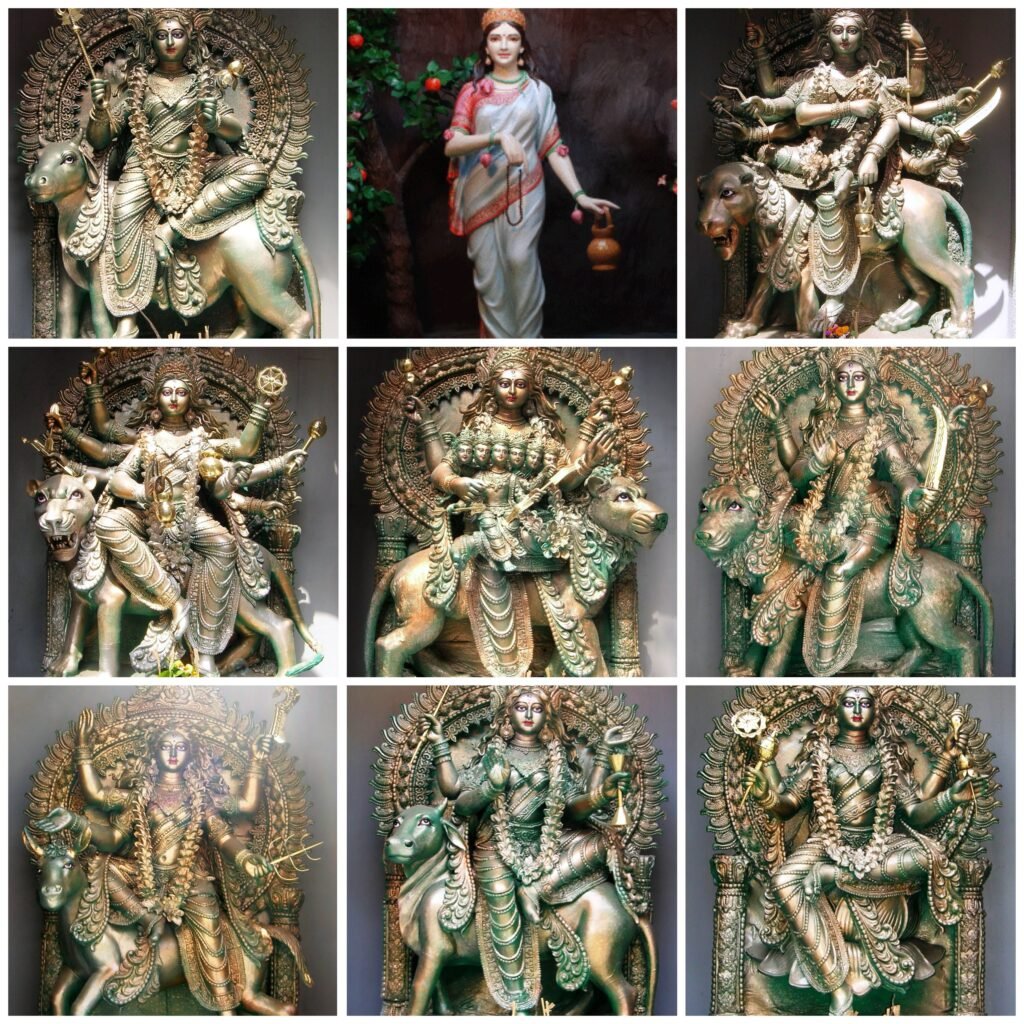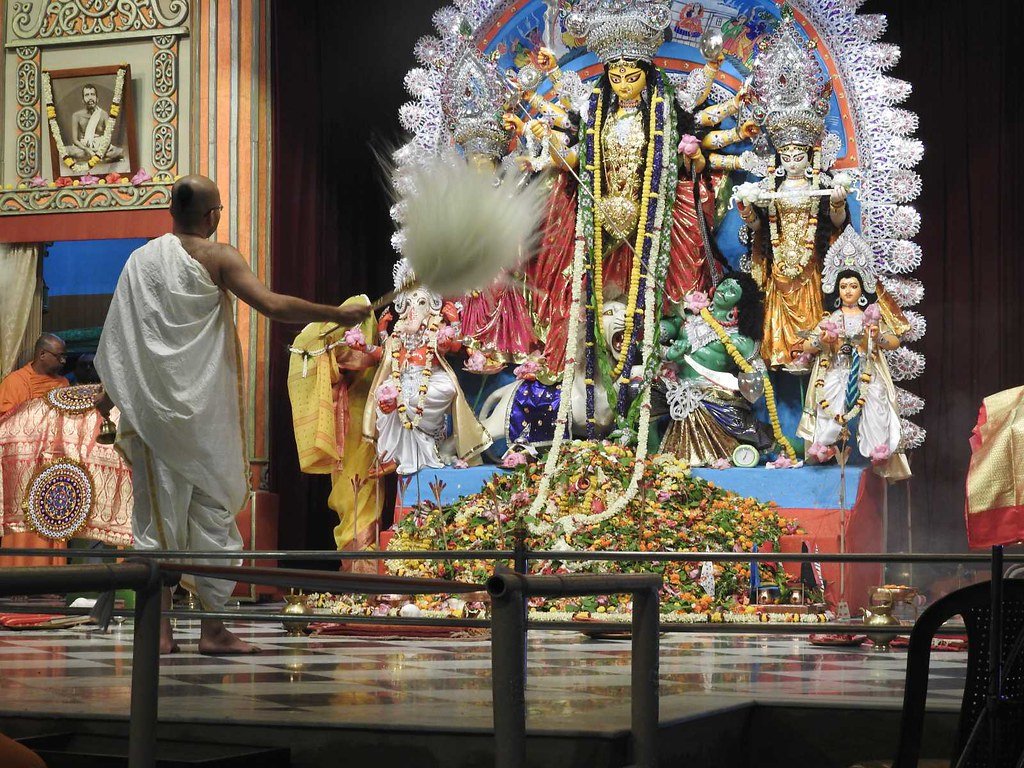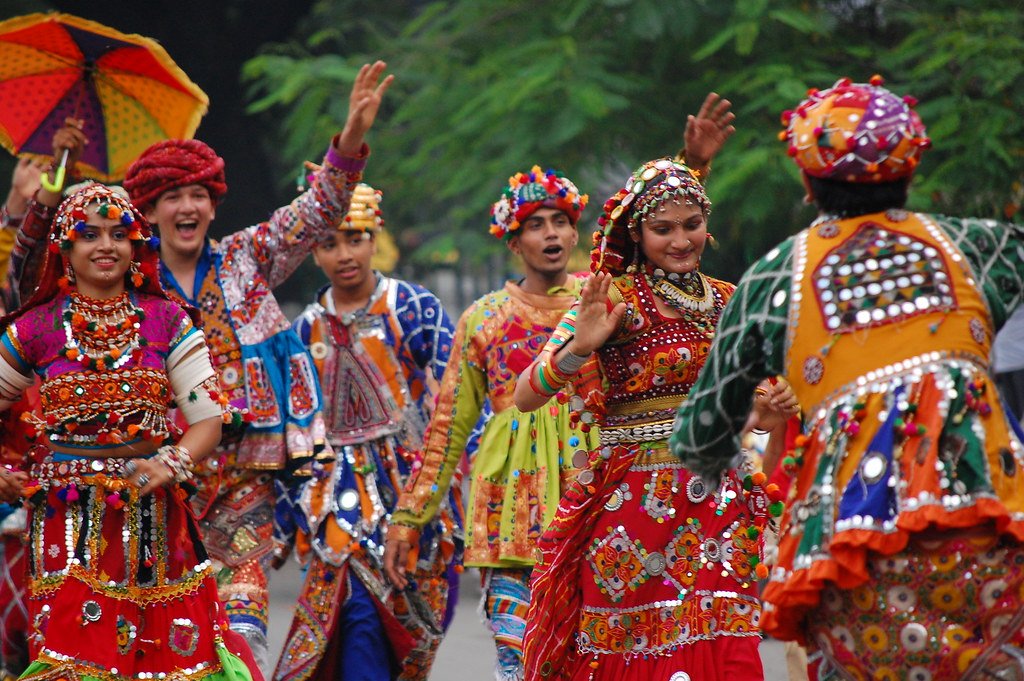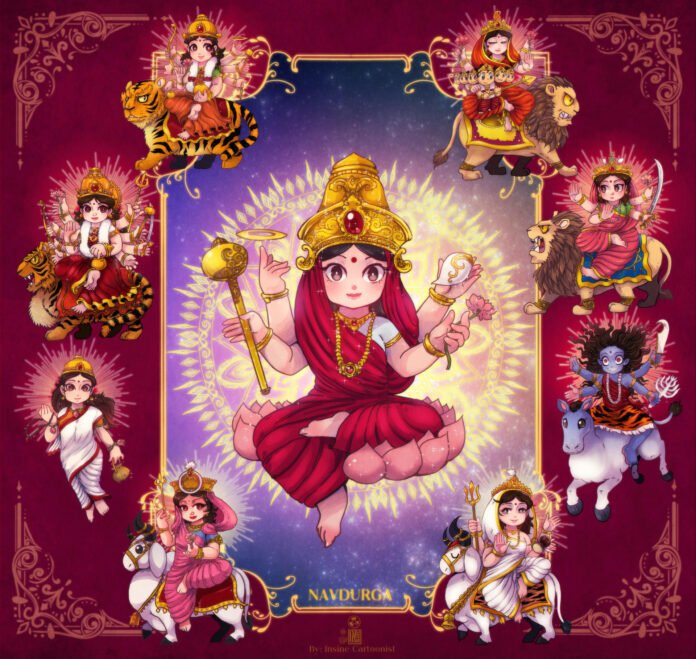Introduction: A Celebration of Shakti
An event of nine continuous nights, Navratri is observed following the main purpose of adoring the principle of the Divine Feminine in which the goddess is associated, a festival devoted to being described in Hinduism. The term “Navratri” literally means “nine nights” in Sanskrit. All these nine consecutive nights are dedicated to different forms of the goddess Durga, who gives protection, power, and prosperity.
The nine forms of Durga are called Navadurga and manifest parts of the Divine Female, such as courage, wisdom, compassion, and creativity. Such worship of the nine different aspects of Durga is believed to give one blessings, protections, and the grace of spiritual growth.
Among the popular legends connected with Navratri, the fable of Durga is that of Mahishasura, and it has become a classic. Mahishasura was a terrible demon that had vanquished gods and taken control over the universe. The gods dispatched Durga, a fearful warrior goddess. Demons and deities involved in a nine-day vigorous battle and, at last, Durga killed Mahishasura. That victory of Durga upon the demon sparked the tradition to celebrate victory over evil on every Navratri.
Significance of Navratri: The Nine Reinforcement Forms of Maha Shakti

Day 1: Shailaputri(The daughter of the Mountains)
Literally in Sanskrit, “daughter of the mountain”, this name is indicative of her divine origin from the Himalayas—the abode of the gods. Associating her with mountains revealed quite literally: it argues about her grounding, stability, and capacity to withstand challenges and rise above adversity.
Shailaputri is the most dignified and influential form of Goddess Parvati, Lord Shiva’s consort. Softness and tenderness are epitomized by Parvati; in the incarnation of Shailaputri, she radiates strength, bravery, and steely resolve.
In her blessings, it is believed that she bestows strength of will and stamina—symbolized through association with mountains.
Courage and Fearlessness: Shailaputri is a warrior goddess whose great valor and fearlessness at the time of calamity she possesses. Groundedness and Stability: An earthly and mountainous connection indicates a capability to remain grounded and stable amid chaos. Prosperity and Abundance: Shailaputri is said to confer blessings of prosperity and abundance in matters concerning wealth and material prosperity.
The devotees, by offering their worship to the form Shailaputri, with the grace of the Goddess, are anointed with the boon of strength, bravery, stability, and prosperity in the devotees’ life.
Day 2: Brahmacharini (The Celibate One)
Is the second form of Goddess Durga worshipped during Navratri. The name “Brahmacharini” means “one who practices celibacy” or “one who lives the life of a student.” This form of the goddess is associated with discipline, renunciation.
According to Hindu mythology, Brahmacharini is a young single woman figure holding a japa mala or rosary in her right hand, and a Kamandal, or water pot, in her left: mala indicating austerity, Kamandal indicating subsistent and simple life.
One of the main themes associated with Brahmacharini is a development of self-discipline and self-control brought with spiritual growth. Self-discipline and renunciation shall help a person tame desires and insignificance, and in that way develop better focus, stronger concentration, and enhancement of spirituality. Some of the key features that are associated with Brahmacharini are: discipline. The goddess is spoken about being very disciplined and dedicated to her spiritual practices. Renunciation: She is associated with the renunciation of worldly desires and attachments.
Self-Control: Brahmacharini characterizes the power of self-control and the ability to contain temptations.
Wisdom and Knowledge: Having studied the Vedas, Brahmacharini explains knowledge and wisdom. While one reasons using knowledge and wisdom of Brahmacharini, they automatically receive the blessing of disciplined self-control and spiritual growth, respectively.
Day 3: Chandraghanta (The Bell Sounding Goddess)
There could be observed two unusual characteristics that still observe and characterize Chandragh
The crescent moon on her forehead associates her with the Divine feminine and cosmic rhythms, representing peace, purity, and cyclical time in which she can balance fierce and tender energies.
Bell (Ghanta): It represents spiritual awakening by ringing the bell and symbolizes the presence of divine energy. The sound of the bell is said to cleanse from stumbling blocks and prevent inauspicious forces from entering one’s house or premises. It is also an announcement to the universe that the divine presence is about to take place.
Her form alternates with being terrible and splendid to reveal both aspects. A demonstrates her dual nature both protector and force of destruction.
Meaning of Chandraghanta
ChandraghantaЅ embodies deep spiritual significance:
Courage: She represents the courage required to deal with and overcome fear and obstacles. Her fierce appearance highlights the strength required to meet challenges and adversities.
Sound of Divine Presence: The sound of this bell represents communication with the divine. The calling into consciousness speaks of the all-pervading divine energy that guides and protects.
Protection and Power: Devi Chandraghanta is worshiped for her energy to protect against negative forces and to be strong in facing all other parts of life. She is called upon for protection both from the spiritual inside the person and also from the physical world outside one’s self.
Day 4: Kushmanda (The Creator of the Universe)
Kushmanda is visualized with unique features that illustrate profound spiritual significations :
Radiant Aura: The radiance is completely associated with Kushmanda, which defines her to be shining by her very own divine energy and light of creation. More or less, this may define her very purpose of being that entity to illuminate the cosmos and then spread life.
Riding a Lion: She rides a lion, which is a symbol of strength, courage, and majesty. The lion best represents her nature, powerful and kingly, which means she is of a high status to create and sustain the universe.
Cosmic Egg: This word itself is the paradigm that she is the cosmic egg from which the universe was hatched. The word Brahmanda actually means cosmic egg, showing her as the basic resource of creation, the beginning of whatever exists in this universe.
Significance of Kushmanda
She occupies an extremely exceptional seat and place in spiritual practice and worship:
She is the creative force, the intrinsic energy behind the creation of the universe. Her presence reminds of the very fundamental power of creation that rises and sustains all forms of life.
Health and Prosperity: The worship of Kushmanda is said to provide health, prosperity, and success. Her creative energy is attributed to giving abundance, both on the material and spiritual planes.
Sustenance: She is the goddess of creation and sustenance, in ensuring that life keeps going on and increases in its rhythm. It is believed that she provides good health and peace in physical and spiritual terms.
Essentially, Kushmanda is the origin to all created objects, the divine energy that brings forth incredibly huge, powerful, and massive things and beings. Her significance of generating creativity, prosperity, and sustaining divine feminine power is thus bestowed upon beings.
Day 5: Skandamata (The Mother of Skanda)
Skandamata, another aspect of the Goddess Durga during Navratri, bears certain attributes which read:
Skandamata Holding Her Son, Skanda (Kartikeya): Shown carrying god of war Kartikeya as her son, Skandamata represents a mother who is caring and protective. In her lap, Skanda shows courage and power, but that of the mother shows immense affection and support.
Riding on a Tiger: Goddess Skandamata is seen on a tiger, showing her supreme power and authority. The tiger is held as the very emblem of courage, strength, and royalty that were vested with the power of preservation and protection with compassion and supremacy.
Maternal Care and Love: She stands for the motherly instincts of the world. Depicted with Skanda, it points towards how protective and supportive in nature, thereby explaining the sense of warmth and security attributed to maternal love.
Protective and Nurturing Aspects: Being the mother of Brahma and supporter of Skanda, Skandamata reflects the twin features of protection and nurturement. The way she supports and protects her child reflects the power to protect the devotees from physical as well as emotional threats.
In a nutshell, the symbolism and meaning of Skandamata is in the divine part of motherhood that merges protection and nurturing care with the bestowal of peace and prosperity. Her worship is an invocation to the protective and loving energy that sustains and supports an individual’s spiritual and worldly efforts.
Day 6: Katyayani (The Warrior Goddess)
Goddess Katyayani is depicted with distinctive features to emphasize her formidable and protective nature:
Aggressive Warrior Pose: Katyayani is usually projected in an active and aggressive stance, depicting her role as fierce and an active force against the evil. This simply identifies her readiness for battle and dynamic action in fighting back the binding forces.
Riding a Tiger: She rides a tiger, a powerful symbol of strength, courage, and majesty. And she rides a tiger—victorious, dominating, and pre-eminent—showing her fearless nature and an ability to command respect and authority.
Holding Many Weapons: Katyayani is shown holding several weapons, such as sword, trident, and spear, and she is sometimes shown holding noose and mace. All these weapons are interpreted to source of her power of fight and destruction to evil, hence making her a goddess who protects and fights.
The goddess Katyayani represents numerous critical attributes of divine power and protection:
Courage and Strength: She truly reflects courage and inalienable strength that needs to be faced with all evils. Her rough look and warrior posture symbolizes courage to face, conquer bigger problems and adversities.
Power of Destroying Evil: Worshipping of Katyayani is done for the potentiality of destroying evil powers and demonic energies. Her energy is invited for the removal of obstacles vitiating it, giving protection from harm and making balance and righteousness.
Getting Over Adversities: Devotees pray for strength to overcome personal and spiritual adversities. Her fierce nature inspires a believer in Katyayani to confront his miseries boldly, with the necessary fortitude of rising above life’s problems.
Basically, the myth of Katyayani and her symbolism represents a wild and powerful deity that is identified by the powers of being strong, warrior-like, and a victor of evil. Worship to her is a way of inviting divine support to fight adversities and remain spiritually and physically strong.
Day 7: Kalaratri (The Dark Night Goddess)
Kalaratri is the fiercest form of Durga, symbolizing how intense she can be in representing a force of great change:
Dark Complexion: Kalaratri is black or dark in complexion, representative of the depth and mystery of cosmic forces. This depicts a void from which creation happens, and it intensifies her ferocity in the deep and most often challenging spiritual change.
Wild Hair: Her wild or disheveled hair plays harmoniously into her scary looks, bringing to mind the kind of unbridled power she holds. This clearly reflects her connection with primordial forces and her readiness to battle chaos and disaster.
References of the Fierce Protector: A fearsome expression and visage, Kalaratri’s overall appearance makes her fearsome and intimidating—an allusion to her nature as a ruthless guardian and evil destroyer. Formidable visage—the face depicting the reminder of strength towards the negativity to be faced up and done away with.
Sword and Noose: She also holds a sword and a noose –a powerfully variating figure, demonstrating her power to cut off falsity and bind or control forces of the demonic. The sword would symbolize the razor-sharp quality of discerning and of reckoning to cut bindages wide open while the Noose would symbolize capture and subjection of evils.
Meaning of Kalaratri
Kalaratri Is the very embodiment of both the changeable and protective forms that her worship is based on :-
Transformative Power of Destruction: With all her dreadful appearance, Kalaratri represents the crucial process of destruction for transformation. She embodies the notion that annihilation is a cycle of creation, wherein old forms have to be demolished for new growth.
Removal of Obstacles and Fears: People consider Kalaratri to be the goddess who removes all obstacles and fear from life. Her destructive power would work in clearing negative influences and barriers deterring spiritual or personal growth.
Destruction of Ignorance and Negativity: Her role goes even farther into the plane of destruction of ignorance and spiritual darkness. By facing and then destroying those very obstacles, Kalaratri helps effulgence of the path toward enlightenment and higher understanding.
At the last, the symbolism and importance of Kalaratri reflect a most great force of transformation, in whose terrible appearance lies her power to eliminate the most stubborn obstacles, as well as fears and ignorance. Here, her worship becomes a call to unite the power of destruction for spiritual purification and renewal and brings out that facing and rising above challenges is an important part of the journey toward enlightenment.
Day 8: Mahagauri (The Great White Goddess)
Further, Mahagauri is considered to be the most worshipped form of the goddess Durga, radiant and peaceful. Radiant, White Complexion: Mahagauri has a luminous white complexion, which portrays the brilliancy of serenity and purity of divine light. Her white skin is symbolic because she reflects purity and spotlessness, explaining a state of spiritual clear light or transcendence.
Bull: She is also shown riding a bull, which is a symbol of power, stability, and righteousness. The bull, however, symbolizes the power and capability of sustaining and supporting the rightful course. It also represents her rooting in the divine and physical worlds.
Holding a Trident and a Drum: In her right hand, she holds a trident, symbolizing, in simpler words, her power to control and balance the forces of creation, preservation, and destruction. A drum in her left hand is in representation of the cosmic sound that resonated in its resonance, which brought into initiation the existence of the form of creation, therefore prospering the cycle of creation against time to give harmony and rhythm in this universe. In her, these characteristics show the maintenance of cosmic order and harmony.
Mahagauri symbolizes purity, knowledge, and serenity; these are the key elements of worship in her:
The Ultimate Purity and Serene Nature: Mahagauri is the symbol of the highest purity and most peaceable nature. With an incandescent countenance, she would also mean a reflection of the divine essence that is purely devoid of any impurities and any disturbances. Worshipping to her is believed to foster a sense of peace and clarity in one’s life.
Wisdom and Clarity of Mind: Devotees pray for a crystal clear mind, not wavering between good and bad. The divine energy of Mahagauri is believed to enhance the level of understanding or insight one has and, thus, it gives directions and explanations on both spiritual and material subjects.
Purity of the Soul: Her worship is connected to the purity of the soul. Prayers and calls for Mahagauri’s energy are believed to clean the inner self from all negative influences and make it in a state of spiritual purity.
To sum it up, the symbolism and importance of Mahagauri witness her as the bedrock of purity, wisdom, and tranquility. People worship her for acquiring actual cleanliness of heart, mind clarity, and ultimate feeling of peace within oneself. She plays a very vital role in directing her devotees to spiritual advancement and tranquility.
Day 9: Siddhidatri(The Bestower of Siddhis)
Siddhidhatri is the ninth form of the goddess Durga and the symbol of the culmination of divine power and fulfillment of any desire. The iconographic meaning of Siddhidhatri carries immense symbolism of high spiritual order:
Four Arms: She is depicted with four arms, in which she carries some emblem of value:
Mace (Gada): Denotes the might and capability to crush all obstacles.
Lotus (Padma): Symbolizes purity, spiritual illumination, and disengagement from the surroundings.
Conch (Shankha): Represents the eternal sound of creation and the distribution of divine knowledge.
Discus (Chakra): A symbol of the endless time-cycle and total destruction of the wicked.
Lotus: A lotus flower symbolizes an awakening of the spiritual, developed mind over fetters of matter, in which the energy of consciousness is bloomed keeping over the material world. Symbolizes purity, grace, and the essence of Siddhidhatri.
Importance: Siddhidhatri is worshipped as the ninth form of Goddess Durga, on the ninth day of Navaratri. She is the fulfiller of the highest realization of spiritual powers and the bestower of all siddhis (supernatural powers) and achievements. She is worshipped to be fulfilled with desires, spiritual attainments, and the highest realization of one’s self and the divine. She also symbolizes moksha, the idea of liberating one’s soul, precisely helping her devotees transcend the chakras of birth and death.
Traditions and Rituals of Navratri
Navratri is one of the most important major Hindu festivals celebrated with great devotion and enthusiasm all over India. The festival spans nine nights and is dedicated to worshiping the nine forms of Goddess Durga. Since Navratri includes various traditions and rituals, it almost differs with little variation as per the regional practice but anyhow carries the common features of devotion, celebration, and display of culture.
1. Fasting and Feasting
Purity of both mind and body is sometimes sought through fasting. Variations run from those who stick to a water diet to those who only eat one meal a day or only eat such things as fruit, milk, and esoteric fasting foods. Indians believe that fasting makes their minds and bodies more receptive to spiritual energies and blessings.
Importance of Specific Foods: Those consumed are usually sattvic foods avoiding grains, onions, garlic, among other spices. common fasting foods include
Kuttu (buckwheat) flour, which is used to make puris or pancakes
Sabudana (tapioca pearls), which are made into khichdi or vadas
Singhara (water chestnut) flour, another common ingredient for puris or halwa.
Fruits and dairy: General food to eating in plenty during the fast. This kind of food believed to stand in place for consistency and energy, ensuring cleanness of the mind and concentration to focus on devotion.
The ending day of Navratri is Navami, on which the devotees break their fast with a grand feast. This grand feast usually includes many traditional dishes and sweets, prepared with love and dedication and offered to the Goddess before being shared among the family.

2. Puja and Aarti
Puja (Worship): Daily worship is also a major part of the day during Navratri. Devotees set up the idols or pictures of Goddess Durga in elaborate setups. They offer puja to the Goddess with a lot of reverence, offering flowers, fruits, and special dishes. Every day of Navratri is dedicated to one specific form of Durga, and, of course, the prayers and offerings are customized accordingly to serve specific attributes corresponding to that form of Durga.
Aarti: It refers to waving of the lighted lamp in front of the deity while devotional songs are being sung. Aarti is a very important part of Navratri rituals and performed during morning and evening puja. The aarti is symbolic to take away darkness (ignorance) and ushering light (knowledge and wisdom). Afterwards, the lamp is taken around and followers cup their hands over the flame and then touch their foreheads in veneration to the Goddess’s blessings.

3. Decorations and Garba Raas
Decorations: Homes, temples, and public places are decorated with bright decorations. Commonly used decorations in these places comprise bright rangolis, lightings, flowers, traditional motifs, great detailing of clay Durga idols, among other decorations. In some places, clay Durga idols are detailed decoratively and set within pandal temporary structures.
Garba Raas: Particularly popular in relation to Navratri is its link to Garba and Dandiya Raas, folk dances from the state of Gujarat. Essentially a circular dance around a central lamp or an image of the deity, Garba then translates into the cyclical path of life. Graceful movements with twirling done to rhythmic beats, performed by both men and women in traditional attire, it is. Another dance type is Dandiya Raas, a dance played with sticks known as dandiyas. This is a dance done by pairs. These dances don’t only pertain to worshipping the gods but also merry-making of life as a people in a community. Most of these different dances are characterized by most of them continuing until late at night as the young and old people enjoy dancing.
Navratri, literally, is the tapestry of a lot of rich rituals which inlay fasting, feasting, and cultural celebrations, all replete with the spirit of devotion, unity, and joy—times when the wider community comes together in the praise of the divine feminine and to celebrate the triumph of the divine over evil.

The Significance of Navratri in Modern Times
Navratri, a festival rooted in ancient traditions, continues to hold profound significance in modern times. As society evolves, the festival’s themes of empowerment, spiritual growth, and community take on new relevance, resonating with contemporary values and challenges.
1. Empowering the Feminine Divine
Celebration of the Divine Feminine Energy: Navratri is basically the worship of Goddess Durga in her varied forms, each depicting different aspects of feminine power associated with courage, wisdom, nurturance, and protection. In today’s contemporary world, which speaks about women’s empowerment and gender equality, Navratri’s celebration is more than just revelry. It becomes a testimony to how divine femininity should be treated and venerated. It showcases the powers of strength, resilience, and creative energy flowing through every female form.
Modern Relevance: Celebrating the divine feminine energy through Navratri is a calling towards the empowerment of womankind echoed throughout various contemporary movements. It calls for validating the place of feminine qualities in daily life, in boardrooms, and in every sphere of life. It also calls for balancing energies, not only masculine but feminine ones in equal measure so as to mark a world of harmony and equality.
2. Spiritual Growth and Self-Reflection
A Time for Self-Improvement – Navratri is not only a festival of external observance but also a time for internal contemplation and spiritual growth. The nine days mean a time for self-purification—physically, mentally, and spiritually. The fasting, meditation, and prayers make a man turn away from mundane things and refocus on inner purity.
Inner Exploration: The present time, exerted with the breakneck pitch principles, demands quiet introspection. It is a time of reevaluation of goals, habits, and relations to be in a state of harmonious adjustment, reflecting spiritual aspirations with higher values. Devotion and discipline that Navratri calls for can facilitate self-realization where an individual may come into better contact with one’s inner self and be nurtured in the virtues of patience, humility, and gratitude.
3. A Celebration of Community
Unifying Elements: Navratri is a festival that unifies people through all levels of stratification, social, economic, and cultural boundaries. Indeed, such feeling of togetherness and cheer makes way from the community pujas, Garba nights down to a small gathering within the family or a group. It is, in all respects, that period when families and friends get together to celebrate and support bonding, and this makes the observance extremely memorable.
Modern Times Relevance: In today’s contemporary world of disintegration and individualism, the community features of Navratri light up the importance of togetherness and collective celebration. The festival encourages modern humans to get in touch with their roots, traditions, and each other. It also offers an opportunity to experience the joy of giving, whether through charity, sharing food, or simply participating in community activities. It is this collective spirit that fosters social cohesion and a sense of belonging in diverse worlds.
Conclusion
What stands the test of time in Navratri is its adaptability to continuous relevancy in life today. It empowers the individual with the glorification of feminine power, gives him the space to grow and deepen his identity in spirituality, and brings communities into days of copious joyous celebration. Navratri, itself ever-changing with the times, struggles to evolve in different ways that offer new wisdom and strength to the current labyrinth of modern life.


